Wijk aan Zee 2008

GM Mihail Marin in his analysis kitchen at home in Romania
The following express commentary was provided by Romanian grandmaster Mihail
Marin, who is the author of a number of very popular ChessBase
training CDs and articles for ChessBase Magazine. GM Marin will study the games
of the World Championship tournament in much greater detail and provide the
full results of his analysis in the next issue of ChessBase
Magazine.
Round eight commentary by GM Mihail Marin
Most players seem to have been somewhat tired after the eventful seventh round.
We only had three real fights and just one decisive game.
| Group A: Round 8 - Sun. Jan. 20nd |
| Loek van Wely - Peter Leko |
½-½ |
| Magnus Carlsen - Boris Gelfand |
½-½ |
| Vishy Anand - Veselin Topalov |
1-0 |
| Vladimir Kramnik - Judit Polgar |
½-½ |
| Teimour Radjabov - Vassily Ivanchuk |
½-½ |
| Shak. Mamedyarov - Levon Aronian |
½-½ |
| Pavel Eljanov - Michael Adams |
½-½ |
Playing with black against Anand, Topalov employed a strategically ambitious,
but rather time consuming plan. The World Champion reacted with great precision
and Black soon found himself under pressure on both wings. Topalov tried to
keep things under control on the queenside, but got under a strong positional
attack on the kingside. On the 40th move he resigned in a joyless position.
In Carlsen-Gelfand and Kramnik-Polgar Black sacrificed a pawn in order to
annihilate White's pressure and get some initiative in exchange. In both cases,
White retained his extra pawn until deep in the endgame, but accurate black
defence led to draw after 67 and 49 moves, respectively.
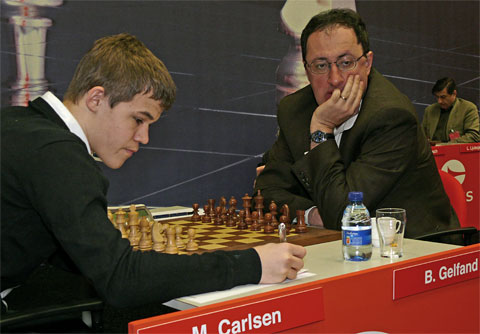
Tournament leader Magnus Carlsen faces Boris Gelfand
The other games ended in "correct", although rather uneventful draws,
in the range between the 20th and 28th move.

Kramnik,V (2799) - Polgar,Ju (2707) [A15]
Corus A Wijk aan Zee NED (8), 20.01.2008 [Mihail Marin]
1.Nf3 Nf6 2.c4
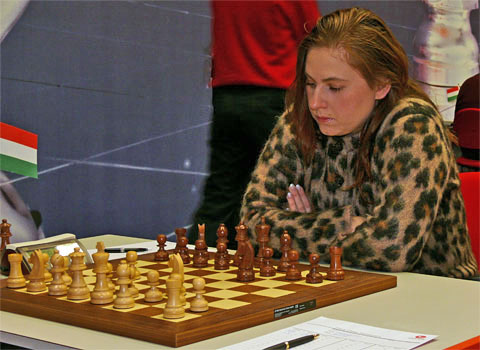
2...b6 3.g3 Bb7 4.Bg2 e6 5.0-0 Be7 6.Nc3 0-0 7.Re1
More than a decade ago, a young rising star named Kramnik started employing this
line with great success, causing nightmares to many specialists of the Queen's
Indian, including Anatoly Karpov. The mature ex World Champion Kramnik still believes
in the merits of White's position...
7...d5 8.cxd5 exd5 9.d4 Nbd7. A more
common way to dveelop the knight is 9...Na6 followed by ...c5. One of the main
ideas is that in case of dxc5 the d5-pawn is protected and Black can opt for the
hanging pawns with ...bxc5 rather than for the isolated pawn with ...Bxc5. As
will become clear a couple of moves later, Judit has entirely different plans.
She does not wish to weaken the d5-pawn at all and will keep the c-pawn on its
initial square, aiming for active piece play.
10.Bf4 Ne4 11.Qc2 Bd6!?
Finally abandoning the territory that was familiar to Kramnik from his own games.
After 11...c5 12.dxc5! Bxc5 13.Nxe4 dxe4 14.Ng5 Black had problems protecting
his central pawn (ex-d5 pawn) in Kramnik-Van Wely, Tilburg 1997.
12.Nxe4 dxe4
13.Ng5 Bxf4 14.gxf4 Nf6 15.Nxe4 Bxe4 16.Bxe4 Nxe4 17.Qxe4
Black has reasonable compensastion for the sacrificed pawn. After the exchange
of all the minor pieces the white king's residence has been weakened, while the
exposed situation of the white queen will allow Black develop some initiative.
17...Re8 18.Qd3 Qf6 19.e3 Rad8
Black completes her development and threatens to undermine White's centre with
...c5. After an eventual exchange on d4, the chronic structural weaknesses would
make White's extra-pawn irrelevant, while after d5 the b2-pawn would be hanging.
We can notice a curious reversal of scenario: it is Black now who submits the
d4-pawn to strong pressure... From psychological point of view, a partial success
for Judit.
20.Qc2 Rd5 21.Rad1
White has prepared against Black's counterplay in the centre in the best possible
way. However, his queen is a little too far from the kingside, which allows Black
hit from the other side with
21...g5!? 22.Qxc7. 22.fxg5?! Rxg5+ 23.Kf1
Qf3 offers Black excellent attacking chances. Not something one would like to
test against Judit.
22...gxf4 23.exf4 Rxe1+ 24.Rxe1 Rxd4
The position has simplified and White's extra-pawn is not too relevant from static
point of view. However, the open position of both kings induce certain dynamic
elements.
25.Re3 h5 26.Qe5 Qxe5 27.fxe5
White has managed to improve his structure, but the active placement of Black's
rook makes a draw look like the most probable result.
27...Rd2 28.Rb3 Kg7 29.Kg2
Kg6 30.Ra3 Rxb2 31.Rxa7 b5 32.Kg3 h4+ 33.Kf3 b4 34.h3 Rc2 35.Ra4 Rb2 36.Ra7 Rc2
37.Rb7 Rb2 38.Kg2 Rxa2 39.Rxb4 Kf5 40.Rxh4 Kxe5
From Black's point of view, the presence of the f7-pawn makes this an improved
version of the (basically drawn, but still unpleasant) endgame Aronian had against
Kramnik two rounds earlier. 41.Rg4 Kf5 42.Kg3 Ra3+ 43.f3 Ra1 44.Rf4+ Kg6
45.Rb4 Rg1+ 46.Kf2 Rh1 47.Rg4+ Kf6 48.h4 Ra1 49.Kg2 and Kramnik resigned
himself to the somewhat surprizing fact that he cannot win any drawn rook ending...
1/2-1/2. [Click to replay]
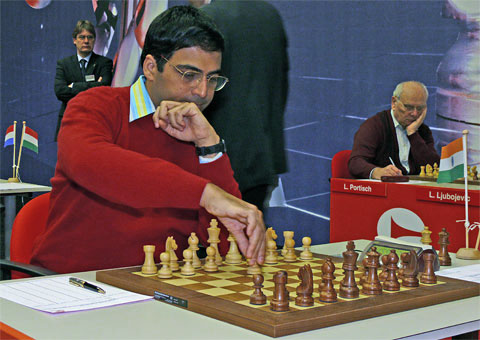
Vishy Anand plays 1.e4 against Veselin Topalov in round eight
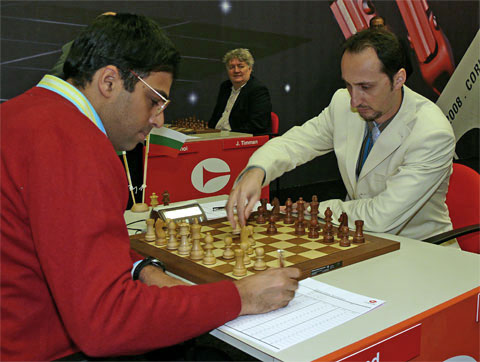
The game proceeds 1...c5 2.Nf3 d6 3.d4 and Topalov plays 3...cxd4
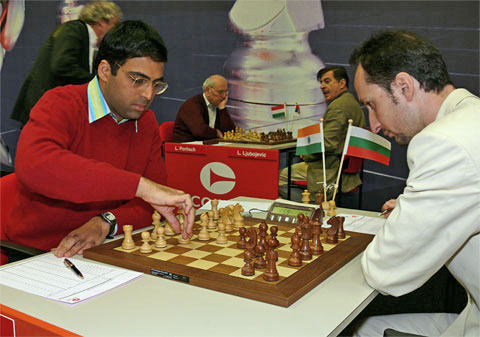
4.Nxd4 Nf6 5.Nc3 a6 6.Be3 e5 7.Nb3 Be6 8.f3 and we reach the position of the
first diagram below.
Anand,V (2799) - Topalov,V (2780) [B90]
Corus A Wijk aan Zee NED (8), 20.01.2008 [Mihail Marin]
1.e4 c5 2.Nf3 d6 3.d4 cxd4 4.Nxd4 Nf6 5.Nc3 a6 6.Be3 e5 7.Nb3 Be6 8.f3
8...h5. This prophylactic move, preventing (or, at lest, slowing down)
the standard attack based on g4-g5, becomes incresingly popular. 9.Nd5.
Deviating from a game played at an earlier stage of the same tournament, which
continued with 9.Qd2 Nbd7 10.a4 Be7 11.Be2 Qc7 12.0-0 0-0 , Leko-Topalov, Wijk
aan Zee 2008. After White's short castle, it is not easy to take advantage of
the relative weakness of the black kingside. Besides, if we compare to the 6.Be2
e5 7.Nb3 lines of the Najdorf, ...h5 cannot be considered a loss of time, because
White also played the generally unfavourable f3 (this square is usually left
available for the bishop, ever since Karpov used the line to defeat Portisch
decades ago). Anand's move is logical in a deeper sense. Since Black has spent
a tempo on a pawn move which has little to do with the fight for the centre,
White is in a favourable position to maintain the advantage of space he obtains
after the inevitable exchange on d5. 9...Bxd5 10.exd5 Nbd7 11.Qd2

11...g6 12.0-0-0
12...Nb6!? The start of a very ambitious strategic plan, which, however,
will cost Black considerable amount of time. The neutral developing moves 12...Rc8
13.Kb1 Bg7 might have been safer.
13.Qa5. The only way to defend the d5-pawn,
but now Black can carry out the strategically favourable exchange of the dark-squared
bishops with
13...Bh6 14.Bxh6 Rxh6 15.Kb1 Rc8
From static point of view, Black's position looks great. He has exchanged his
potentially "bad" bishop. Besides, with the centre blocked, knights
are supposed to be stringer than White's light-squared bishop. However, the last
operations have caused alarming lack of harmony in Black's camp. The b6-knight
needs two tempi to get to the optimal blocking c5-square, while the h6-rook will
consume quite some time to get into play, too.
16.Qb4! A very important
element in White's regrouping. A small tactical trick (see below) makes the d5-pawn
taboo, allowing White prepare the consolidation of his centre with c4. If his
queen had remained stuck on a5, his position could have become uncomfortable.
16...Kf8. In case of 16...Nfxd5 White would play 17.Rxd5! Nxd5 18.Qd2!
with a double attack, taking full advantage of the awkward placement of the enemy
rook. Black cannot avoid losing material, for instance 18...Qc7 19.c4 Nf4 20.g3.
17.c4 Kg7
18.g3! Another strong move, anticipating an eventual activation of the
h6-rook by means of ...h4 and ...Rh5 and preparing the activation of the bishop.
18...Rh8. The strategically desirable 18...h4 does not seem to work out
too well after 19.g4 . Black's main problem remains that he needs considerable
amount of time to take all the available blocking squares (c5, g5, f4) under control.
For instance 19...Rh8 20.Rc1
(20.g5 is premature and allows Black regroup
in time with
20...Nh5 21.Nd2 Nf4 22.Ne4 Qc7! If allowed one more move,
Black would over-defend his d6-pawn with ...Rhd8, while
23.Qxd6 or 23.Nxd6
can be met by
23...Nbxd5! taking advantage of the hanging position of the
d1-rook.
) 20...Nh7 21.Bd3 Ng5 22.Be4 The weakness of the d6-pawn prevents
Black from transferring his other knight to c5 quickly, while the threat c5 is
in the air... At the same time, advancing the f-pawn after, say, ...Rf8, would
open the king's position too much, while after the more static kingside approach
22...Nh3 23.Rhd1 Nf4 White obtains strong initiative with 24.c5!
19.Rc1 Qc7
20.Bh3 Rce8 21.Rhd1 Re7 22.a3 Rd8 23.Nd2 Nbd7 24.Qc3
Black has finally completed his development, but White's mobilisation of forces
looks more threatening. he has advantage of space in the centre and the possibility
of starting active operations on both wings.
24...a5. Topalov intends
to install his knight on c5 with all the comfort (after...a4), probably underestimating
Anand's next move. One of the last chances to maintain the position double edged
consisted of 24...Nc5 and if 25.b4 then simply 25...Ncd7 , when the relatively
weak position of the white king would offer Black chances for a casual counterplay,
although his position remains passive in general.
25.Bxd7! After the elimination
of one of the knights, Black will not be able to keep both wings under control.
25...Nxd7?! Black is still dreaming about blockade. However, the temporary
lack of defence of his kingside will offer Anand the possibility to launch a strong
attack.
26.f4! Nf6 27.Rf1 b6 28.h3 Qd7 29.f5 Rf8 30.Qe3
White threatens to asfixiate his opponent with g4-g5 followed by Ne4.
30...e4!?
A desperate attempt to activate his play.
31.g4! hxg4 32.hxg4 Re5
[32...Nxg4? lads to mate after 33.Qg5 Nf6 34.Rh1]
33.Rf4 Qd8 34.g5 Nh5 35.f6+
Kg8 36.Rxe4
White has increased his spatial advantage radically, having won a pawn at the
same time. Black's position is helpless. 36...Rfe8 37.Ka2 a4 38.Rc3 Qc7 39.Qd4
Qc5 40.Qxc5
Black's resignation is not premature. White will need some time to
convert his huge advantage into a win, but there would never be a doubt about
it. Once Anand reached the control, Topalov probably did not feel like torturing
himself defending this position. After 40.Qxc5 bxc5 41.Rce3 Black would be forced
to trade all rooks (otherwise White would invade through the e-file). In the
knight ending, White would get a passed a-pawn, retaining a crushing advantage
of space on the whole board, while Black could not activate his pieces easily.
Besides, the d6-pawn and both kingside pawns would be a permanent source of
worries... Frankly, this is a lot more than a World Champion would need to win
a game... 1-0. [Click to
replay]

On the rebound: World Champion Vishy Anand

Comeback with hiccups: Veselin Topalov
Links












